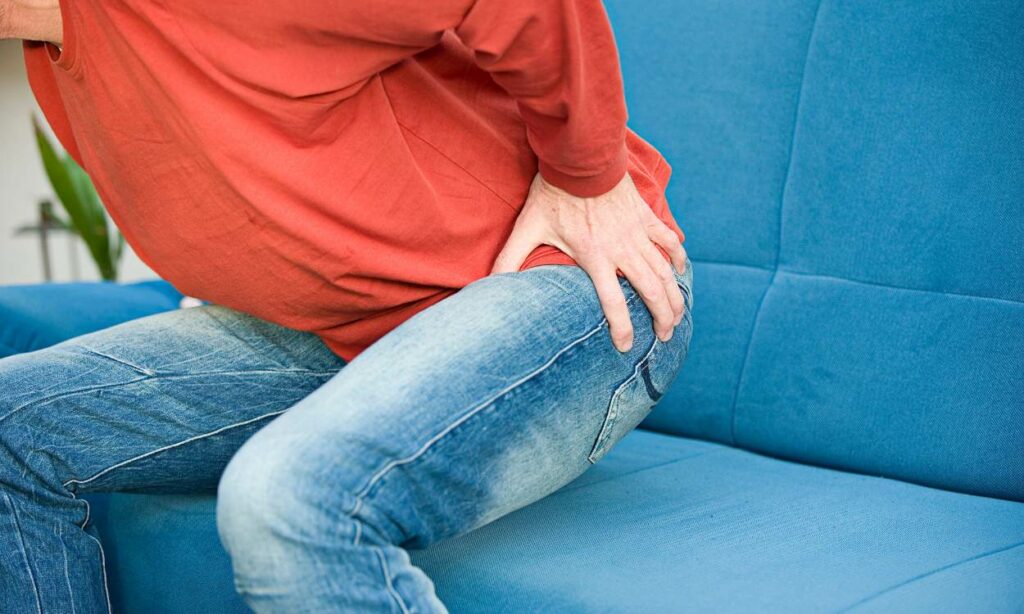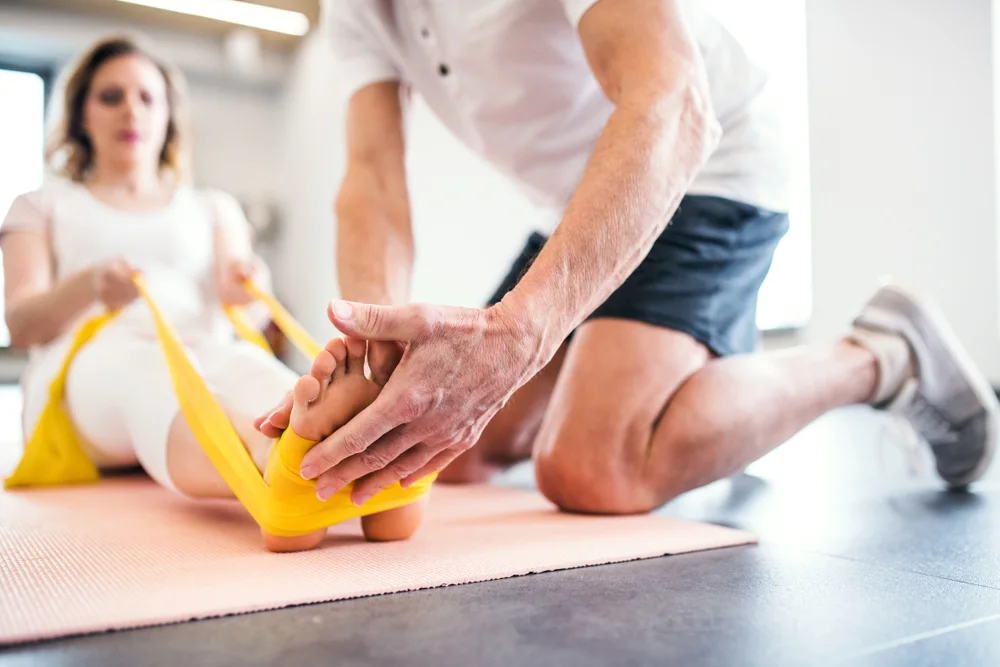In the quiet rhythm of our daily lives, our hips play a pivotal role, whether we’re taking a leisurely stroll through the park or dancing the night away. But when rheumatoid arthritis (RA) enters the picture, it can transform this rhythm into a series of painful notes. The ache, stiffness, and discomfort in the hip can be more than just a physical challenge—it can be a barrier to the simple joys of movement. Dive into the intricate dance between rheumatoid arthritis and the hip, and discover expert tips and remedies to manage the pain, reclaim your rhythm, and keep moving gracefully through life.
Contents
- 1 Understanding The Link: Hip Pain & RA
- 2 Early Signs of Rheumatoid Arthritis in the Hip
- 3 The Impact on Daily Activities and Mobility
- 4 Home Remedies & Self-Care Options for Hip Rheumatoid Arthritis
- 5 Treatment Options Available For Rheumatoid Arthritis In Hip
- 6 Diagnostic Procedures and Tests
- 7 Conclusion
Understanding The Link: Hip Pain & RA
 Rheumatoid arthritis (RA) is not just a simple case of joint inflammation; it’s an autoimmune condition where your body mistakenly declares war on its joints. But why does it have a special affinity for the hips?
Rheumatoid arthritis (RA) is not just a simple case of joint inflammation; it’s an autoimmune condition where your body mistakenly declares war on its joints. But why does it have a special affinity for the hips?
At its core, RA targets synovial joints, which are the types of joints designed for maximum mobility. Think of synovial joints as your body’s little oil cans, filled with a lubricating liquid known as synovial fluid. This fluid ensures that joints like the elbows, wrists, and yes, the hips, move smoothly without friction.
Now, the hip is one of the largest ball-and-socket synovial joints in your body. When RA flares up, the immune system attacks this lubricating synovium in the joint. As a result, the synovium thickens, causing swelling and pain. Over time, if not treated or managed, RA can damage the cartilage and even the bones in the hip joint.
It’s not just the sheer size of the hip joint that makes it susceptible to RA. The hip’s central role in bearing body weight and facilitating movement means that any inflammation or damage here can profoundly affect one’s quality of life.
But there’s hope. By understanding this link, we can better approach treatments and strategies to alleviate the symptoms and maintain hip health.
Early Signs of Rheumatoid Arthritis in the Hip

The saying goes, “A stitch in time saves nine,” and nowhere is this truer than when it comes to the early signs of Rheumatoid Arthritis (RA) in the hip. Detecting the initial whispers of RA can be the key to preventing it from shouting in pain later on. So, what are these subtle signals that the body sends, and why is early detection so crucial?
1. Gradual Onset of Pain: Unlike an injury that might cause sudden, sharp pain, RA pain tends to sneak up on you. Initially, it might feel like a dull ache, especially after periods of inactivity or when you first get up in the morning.
2. Stiffness: Morning stiffness is common in those with RA. If you find yourself struggling to get moving after waking up or feeling like your hip needs a prolonged “warm-up” period, it might be a sign.
3. Reduced Range of Motion: You might begin to notice difficulty in tasks that require hip flexibility, such as tying shoes or picking something up from the ground. The hip joint might feel tighter than usual.
4. Swelling and Warmth: While not as common in the early stages, some individuals might notice mild swelling in the hip area. This swelling can be accompanied by warmth, a sign of inflammation.
5. Occasional Sharp Pains: While the pain is generally dull and aching, there might be moments of sharp, intense pain, especially when putting weight on the affected hip.
6. A Feeling of “Creakiness”: Some individuals describe their joint as feeling “creaky” or as if it’s grinding, especially when moving from a seated to standing position.
Now, why is early detection paramount? While the symptoms start mild, they can intensify if not addressed. If you notice any of these signs, it’s essential not to brush them off as just “getting older” or “a bit of wear and tear.” A consultation with a rheumatologist can provide clarity, peace of mind, and the best strategies to tackle the situation head-on.
The Impact on Daily Activities and Mobility
 The hip joint, often dubbed the body’s ‘ball and socket’, plays a critical role in our everyday movements. From the simple act of standing up to more complex activities like running or dancing, the hip is involved in nearly every motion. So, when Rheumatoid Arthritis (RA) targets your hip, the ripple effects on daily life can be profound.
The hip joint, often dubbed the body’s ‘ball and socket’, plays a critical role in our everyday movements. From the simple act of standing up to more complex activities like running or dancing, the hip is involved in nearly every motion. So, when Rheumatoid Arthritis (RA) targets your hip, the ripple effects on daily life can be profound.
1. Walking and Standing: For many with RA in the hip, a short walk can feel like a marathon. Standing for extended periods can also become strenuous, with discomfort escalating the longer one remains upright.
2. Sitting and Rising: You might think sitting would offer relief, but for many, it’s just the opposite. Prolonged sitting can exacerbate stiffness, making the act of standing up from a chair or couch feel like a Strenuous effort.
3. Bending and Stooping: Activities that require bending at the hip, such as picking up a dropped object or tying shoelaces, can become an ordeal.
4. Sleep Disruptions: Finding a comfortable sleeping position can be a nightly struggle. The pain can often intensify when lying on the affected hip, leading to restless nights and fatigue during the day.
6. Work-Related Challenges: For those with jobs that require physical exertion, RA can be especially limiting. But even desk jobs aren’t exempt, as sitting for extended periods can cause stiffness and discomfort.
Understanding these impacts underscores the importance of management and treatment. While RA presents undeniable challenges, early intervention and effective management can minimize these effects, allowing individuals to retain a significant degree of mobility and maintain a good quality of life.
Home Remedies & Self-Care Options for Hip Rheumatoid Arthritis

Managing Rheumatoid Arthritis (RA) in the hip doesn’t always necessitate frequent trips to the doctor or heavy medications. Sometimes, the simplest remedies are found within the confines of our homes, offering relief and comfort. Here are some home remedies and self-care options to help manage the symptoms of hip RA:
Hot and Cold Compresses
- Hot Compresses: Warmth can help to relax and soothe muscle and joint discomfort. Using a warm towel or a heating pad on the affected area for 15-20 minutes can alleviate pain and stiffness.
- Cold Compresses: Cold can help reduce inflammation and numb the area. Applying an ice pack wrapped in a cloth to the affected hip for 15-20 minutes can provide relief, especially after a strenuous activity.
Gentle Exercises
- Stretching: Gentle stretches can help maintain flexibility and range of motion in the hip. Always ensure you warm up before stretching and avoid over-exertion.
- Low-Impact Activities: Swimming, water aerobics, or cycling can help strengthen the muscles around the joint without adding undue stress.
Weight Management
- Carrying excess weight puts additional strain on the hips. By maintaining a healthy weight, you can reduce the pressure on the joint, slowing the progression of RA symptoms.
Anti-Inflammatory Diet
- Consuming foods rich in omega-3 fatty acids, antioxidants, and other anti-inflammatory properties can potentially reduce RA flare-ups. This includes fish like salmon, nuts, seeds, and leafy greens. At the same time, reducing the intake of processed foods and sugars can also help.
Epsom Salt Baths
- Epsom salt, rich in magnesium sulfate, can help relax muscles and reduce pain. Dissolving a cup of Epsom salt in warm bathwater and soaking for 15-20 minutes can provide relief.
Mind-Body Techniques
- Meditation and Deep Breathing: These can help manage the emotional stress that often accompanies chronic conditions. Setting aside time to focus on breathing and mindfulness can promote relaxation and reduce pain perception.
- Tai Chi and Yoga: These ancient practices combine gentle movements with deep breathing, helping to improve flexibility and reduce pain.
Over-the-Counter Pain Relievers
- Non-prescription pain relievers such as ibuprofen or naproxen can help reduce inflammation and pain. However, always consult with a healthcare professional before starting any medication.
Adequate Rest
- Ensuring you get good sleep and allowing the body to recover is crucial. If your hip is feeling particularly sore, it’s okay to take a day off from exercises or strenuous activities.
Remember, while these home remedies can be beneficial, they should complement, not replace, prescribed treatments. Always consult with your rheumatologist or healthcare provider before making significant changes to your management plan.
Treatment Options Available For Rheumatoid Arthritis In Hip

While living with Rheumatoid Arthritis (RA) in the hip can be challenging, a range of treatment options are available, each tailored to address various aspects of the condition. From non-invasive therapies to advanced medical interventions, the objective remains consistent: to manage pain, reduce inflammation, and improve the overall quality of life.
Physical Therapy
- Pivotal Role: Physical therapy can be a cornerstone in managing RA in the hip. A skilled physical therapist can design a personalized program to improve flexibility, strengthen the muscles supporting the joint, and suggest strategies to protect the hip from further strain.
- Modalities: Techniques such as ultrasound, electrical stimulation, or manual therapy can be employed to alleviate pain and inflammation.
- Tailored Exercises: Specific exercises can be prescribed to enhance mobility, improve balance, and decrease discomfort.
Medications
- Nonsteroidal Anti-Inflammatory Drugs (NSAIDs): Over-the-counter NSAIDs like ibuprofen and naproxen or prescription varieties can help reduce pain and inflammation.
- Disease-Modifying Antirheumatic Drugs (DMARDs): Medications like methotrexate or hydroxychloroquine can slow the progression of RA and save the joints from permanent damage.
- Biologic Agents: These are newer, often injectable drugs that target specific parts of the immune system that spark inflammation, such as Humira or Enbrel.
- Corticosteroids: Medications like prednisone can reduce inflammation and pain, though they are generally used for short-term relief due to potential side effects.
Surgery
- In severe cases where the hip joint has been extensively damaged and other treatments have not yielded sufficient relief, surgical options might be considered:
- Joint Fusion: The bones in the joint are fused together, providing relief from pain but limiting the joint’s mobility.
- Total Hip Replacement: The damaged portions of the hip are replaced with artificial parts in a procedure known as arthroplasty.
Complementary Therapies
- Approaches such as acupuncture, massage, or chiropractic treatments can provide additional relief in conjunction with traditional therapies.
In summary, while RA in the hip presents undeniable challenges, the broad array of treatment options offers hope. Collaborating closely with healthcare professionals, including rheumatologists and physical therapists, ensures a holistic and effective approach to managing and alleviating the condition. Remember, the goal is not just to treat symptoms but to achieve the best possible quality of life.
Diagnostic Procedures and Tests
Diagnosing Rheumatoid Arthritis (RA) in the hip involves a combination of clinical assessments and specific tests.
- Doctors will start by collecting a thorough medical history.
- A physical examination in which the doctor will check the hip for tenderness, swelling, or warmth.
- Blood tests that include an elevated ESR indicate inflammation in the body.
Conclusion
Rheumatoid Arthritis in the hip can be a challenging condition, affecting mobility and daily activities. However, with the right diagnosis, treatments, and interventions, managing and even alleviating the pain becomes possible. Remember, early detection and prompt action can make a world of difference. If you’re experiencing Hip pain, physical therapy for hip pain at PhysioMantra can help: Book an online physical therapy session.



